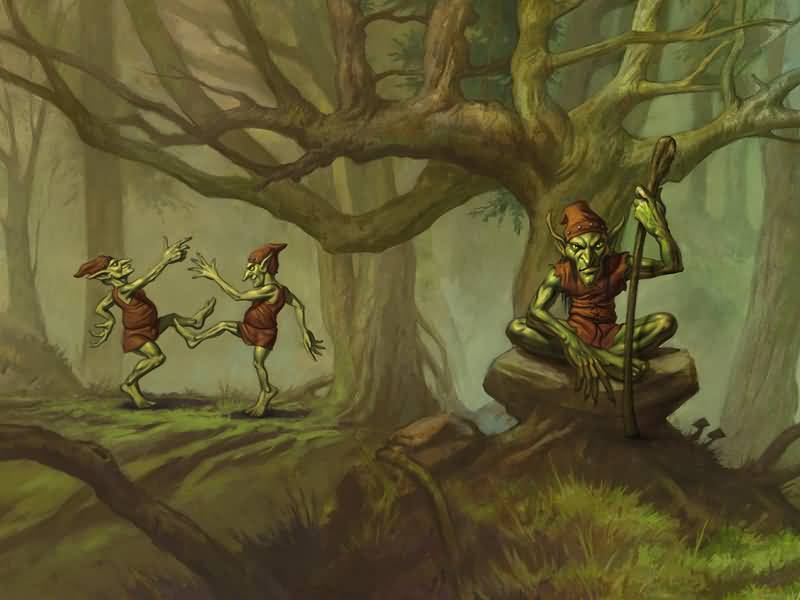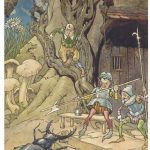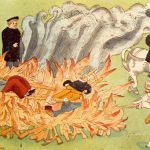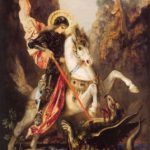In Scotland the word for faery is sith, and is pronounced “shee” just as in the Irish Sidhe. Scottish names for faeries include the Still Folk, People of Peace, The Silent Moving Folk, Pixies, The Wee Folk, and Prowlies.
Scottish Faeries dress in gren and live in burghs just like the Irish faeries. As in Ireland one can hear music come these hillocks at night when one is out. They appear more attached than their neighbours to the monarchical form of government, for the Fairy king and queen, who seem in England to have been known only by the poets, were recognised by law in Caledonia, and have at all times held a place in the popular creed. They would appear also to be more mischievously inclined than the Southrons, and less addicted to the practice of dancing. Scottish witches are known for pouring libations of milk on stones to the faery folk during rituals.

Ashrays: These faeries live in water. They are both male and female and have the appearance of a 20 year old human but they are very ancient. They have whitish, almost translucent skin. They are most active at night and they cannot live on land. If they are touched by sunlight they melt into a rainbow pool of water. They are very rarely seen today and if they are seen at all it is underwater. Their magical and ritual help is unknown and approach with caution if in their underwater world because their intent towards humans is unknown.
Black Angus: In Scotland they are called Cu Sith which means “faery dog”. It is a large black dog with yellow eyes and sharp fangs who roams the Scottish countryside showing himself to those who will die in a fortnight. When showing himself to bring his message of dying he will cross your path, jump in front of you, then turn and growl. Contact is not advised with this faery and he can provide no ritual help.
Boobrie: The Boobrie is a waterbird about a foot high that swims in or out of the water. Their element is water. They live in the waters off the coast of Scotland. It has black feathers and a 3 foot long bill that it uses to catch fish when meat is unavailable. It has large, sharp claws that resemble mangled human hands. They are most active at night and they like to prey on sheep and cattle being transported on ships. It can shapechange into a horse and run along the top of the water and sailors often call the ghost horse. This faery is water bound and cannot live on land. If one really wants to contact a boobrie then do so from the safety of the shore. Call to it and offer it a piece of meat. It is not know how it can help in a ritual or spell since it is a selfish scavenger and there are more reliable faeries to call upon for aid who will be willing to help.
Brownies: These benevolent faeries are found in Scotland and were brought to the New World by Scottish immigrants. Their element is earth. They are also known as House Brownies and are the most kind and benevolent faerie one could hope to meet. They appear as very small male dwarves with coal black eyes. They wear suits of green, blue, or brown with little felt caps. They have pointed ears and long nimble fingers. They are most active at night at any time of the year. They look for deserving homes filled with humble and gracious folk. They do not like cats and will steer clear of homes that have them. They like the attic, woodshed, or cellar of a human home best. Their favorite foods are milk, honey, ale, and cake. They help around the house and farm with the chores. They do not tolerate lying, cheating, and misers. You can invite them in by leaving food out for them and be best contacted on the astral plane in Faeryland.
Buachailleen: These are small faeries that appear as small men. They are known as the Herding Boys. They wear small red hats, which may be inverted flower caps and are excellent shapeshifters. They are mischievous and sometimes border on mean, and they like to torment animals for fun. They are most active in the summer. They play pranks on shepherds and herds and love to tease the animals. Contact with them is not advised. Their element is earth.
Dryads: These faeries are found in all Celtic countries and due to immigrants from the Old World they are now found all over the world. Their element is air. They are tree dwelling spirits. They are playful creatures who seem totally androgynous, though they are always referred to as female. Dryads seem open to human contact but are very capricious. They are active all year particularly at Esbats. They prefer willow trees but are found in all the 13 Celtic sacred trees. Faery willows which lodge dryads are said to walk about at night seeking new locations to lay down roots. They make beautiful music with their voices, sounds which are very compelling to humans. These faeries can be found in the physical as well as the astral realm. They can be found in willow groves or the Faery Triad of oak, ash, and thorn or in rowan, birch, or elder trees. Invite them to your circle and ask them to join in whatever ritual you have planned. Even if they do not show up they may send you helpful energy. They often show up in circles when the guardians of the East are called. They can be persuaded to help teach you the secrets of divination, astral travel, or tree magic.
The Fachan: This Highland faery appears very comical but has a very nasty disposition. His body contains only one of everything; one head, one eye, one ear, one arm, one leg, one foot, one toe, etc. All centered down the center of his body which is hairy and feathered. He carries a spiked club which he swings to chase away visitors from atop his home on the highest Highland mountains. He is active all year. He is very jealous of the gift of flight and hates all other living things and chases them away with his vicious looking club. Contact or ritual help is not advised from this faery.
Fin Folk: Also known as Sea Gardeners and the Lady’s Own. They are anthropomorphic beings who shun human contact though they seem not to wish us any harm. They live beneath the lochs of Scotland. No one has ever met them but there are myths and stories of those who have been taken to their underwater world which is said to be utopian in nature and enclosed in glass . Their favorite pastime is gardening and their underwater world is a paradise of flowers and lush foliage. If you desire contact with them they can found on the physical plane as well as the astral. Approach them with caution since little is known about them. If they show you their world be careful not to offend them or overstay your visit. They may be helpful in lending energy to spells for the protection and preservation of plants and marine life.
The Gruagach: Not to be confused with the Pictish God of the Sun with the same name. She is a solitary female faery, extremely grotesque in appearance but with a heart of gold. She is also know as the Herdswoman and the Firesitter. She carries a shepherd’s staff and her gown is usually green in color but it has been said to be cornsilk gold. She enjoys any brief human contact she can get and will offer whatever help she can in your spiritual quests if you show no fear or revulsion. She is most active in the Summer during the day.
She is primarily a protector of livestock, mainly cattle. She protects herds from the Buachailleen and leads the herds to water. She is always cold loves a warm fire, but being a faery she cannot start her own. To keep warm she makes her home in the Summer of Faeryland. Scottish lore says that when she travels the physical plane she will appear at the doorstep of Highlanders and ask to sit beside the fire. If allowed she will look after the home and herds, if not she will cause trouble and steal animals. Highlanders still pour offerings of milk into hollow stones as offerings to her. She can be contacted on the physical and the astral plane in Faeryland in the Summer. Be aware that she has a very limited attention span. As far as magical assistance she can help in spiritual quests and in guarding herds. She can also lend much energy to spells involving human, animal, or plant fertility.
Ghillie Dhu:The Ghillie Dhu are guardian tree spirits who are disguised as foliage and dislike human beings. They are most active at night and prefer birch trees to all others and guard them jealously from humans. People traveling in enchanted woods must be careful not to be grabbed by the long, green arms of the Ghillie Dhu because they will be enslaved by this faery forever. Scottish forests were once heavily populated by these faeries but now they becoming rare. Contact is not advised.
Heather Pixies: Like other pixies, the Heather Pixies have clear or golden auras and delicate translucent wings. But these faeries are attracted to the moors and the heather that covers them. They are not adverse to human contact but do not seek us out. They have a pranksterish nature about them. They are active all year. They live in fields of heather or on the moors of the Scottish Lowlands. If you wish to approach them do so slowly and let them know that you want to befriend them. Their magical and ritual help is undetermined
Kelpies: Kelpies are faeries who live in water, especially the lochs of Scotland. They are rarely seen anymore. They are small bulbous shaped faeries with huge teeth and pointed ears. They are sly, stupid, and very foul tempered. They are cannibalistic were once densely populated the North Sea and the lochs of Scotland. They fed on deer, other faeries and humans who ventured too close to their abodes. They would appear as seahorses and entice humans to ride them so that they could drown them. They could also shapeshift into very handsome young men in order to lure women but they were unable to change their hair which would appear as seaweed. Their principal home is in Loch Ness which is sacred to them. Contact is not advised !
Ly Erg: This is a singular faery whose element is water. Their is only one of him and he can be easily distinguished since he dresses like a soldier. He is easy to spot from other soldiers due to his small size and his red right hand. He is a portent of death if you see him except with him you have a second chance. If seen he will stop on a road or path and challenge you with a raising of his red right hand. The best thing to do is to retreat since if you fight him you will die within a fortnight. His red hand is result of those who he has killed in combat. He has not been seen in years. He can be found on lonely roadsides near water.
Merpeople: They are more commonly called Mermen or Mermaids depending upon their gender. They have the lower bodies of fish and the upper bodies and heads of humans. They appear as adult males of great beauty and no children have been sighted. They are usually friendly and are slow to anger. But they detest people who desecrate their homes. They are active all year round. There is one race of malevolent Merpeople called the Blue Men of the Muir from Scotland. They have often been accused of causing storms in the North Sea and throwing boulders at ships. They can be sent away by reciting rhymes which confuses them. They can of course can be found at sea or at the seashore and this is naturally the best place to contact them. Use your mind to call out to them. Helping to take care of the oceans is a good way to win their trust. They can be also be found in the astral in Faeryland. They can be called upon in rituals to help save the oceans or finding persons and things lost at sea.
Nucklelavees: These are Scottish sea faeries native to the Hebrides Islands. They are extremely ill tempered and hideous with large bodies and can take on any form they wish but always appear ugly to humans. When not shapeshifting they appear as half human and half horse with fins as feet. They are active all year round. They enjoy coming out of the sea and chasing humans just to frighten them. They are easy to escape by crossing over running water such as a creek or river. They also prey on other faeries. They are extremely foul smelling and are sensed long before they approach. The odor has been described as a cross between rotting eggs and fish covered with mildew. Can be found at seashores but contact and ritual help is not advised.
Pixies: These are small, winged creatures with heads too large for their bodies. They have small pointed ears and noses and arched eyebrows. Their wings are shiny and translucent, and are seen wearing seasonal colors and flora. They are friendly but capricious and are given to non-malicious mischief. They wear caps of foxglove and toadstools, plants they hold sacred. There is no gender differentiation. They are most active in the spring and are found in flower gardens, in wildflower preserves, and in the spring of Faeryland. They are often seen around Beltaine. Their queen is said to be a tiny woman of sublime beauty who has created a spring world in Faeryland. They hate human laziness and also detest iron which will kill them on contact. They are trooping faeries who love dancing, playing, and music. They have gatherings known as Pixie Fairs in Northern England. Pixie dust is a sparkling material seen wherever these faeries have walked. It is a silvery gold material left by their footprints. If you wish to contact them approach with caution and let them know you wish to befriend them. They may respond with mischief. They will not accept invitations to your circle.
The Red Cap: This is a solitary faery and we should be thankful for this since he is dangerous and hateful in nature. He appears as an emaciated man with a leathery body with little or no hair. He carries a sharp wooden scythe with which he strikes down all who invades the area he has chosen to guard. He is active all year and his element is fire. He moves amongst the ruined castles and cairns of lowland Scotland along the English border. He guards these places with his life. The Red Cap he wears has been dipped in the blood of his victims. There have been documented sightings of him.
Seelie Court: Also called the Blessed Ones or The Sluagh. Their element is Air. They are trooping faeries of the winds who have been heard but never seen. Scottish folklore presents them as a huge host of light and benevolence riding on the night air. They are active year round especially on the Sabbaths. They and their counterparts, the Unseelie Court, are a rare example of duality in paganism. The Seelie Court is good and benevolent consisting of the most heroic and beautiful faeries of Scotland. They ride the winds looking down at the earth for any good which they can do. According to Scottish legend they once interacted much with humans. When not trooping they are purported to live underground. This abode is reported to be on the Isle of Skye. Their ritual help is unknown. They seem only to approach humans whom they choose.
Selkies: These seaside faeries are found on the shores of and lochs of Scotland, the Orkney Islands, and the Hebrides. They appear as seals with human characteristics. But they can shed their sealskin and appears as perfect human males and females. Their attitudes toward humans is unknown. They are not as capricious as other faeries but they have very jealous natures. They sometimes take human mates but they sometimes tire of them and leave them to die of broken hearts. Approach them cautiously and mentally call out to them if you feel well protected. Their ritual or magic help is unknown but they may lend their energies to help protect Scotland in times of natural crisis. They are believed to know the secrets of all the world’s oceans and may share this knowledge one day.
Shellycoat: They are small faeries who dwell in pools of shallow fresh water and in woodland lakes. They are fishlike in appearance but have huge mouths and eyes which permits them to see well at night. They round bodies and are usually dark red or purple in color. They bob near the surface with their big eyes showing. They like to play harmless pranks. They are active all year round. Contact is probably not a good idea and would serve no useful purpose. But if one is determined, with a little effort, a witch could befriend these creatures. Their magical or ritual help is unknown.
Shopiltees: These playful little water horses are found in the Shetland and Orkney Islands. They have been seen for over a hundred years now and is now believed they have died out on the physical plane. They were once plentiful in the North Sea and were friendly with both sailors and people along the seashore.
Trows: These squat, round, misshapen faeries with no legs are found in the Shetland and Orkney Islands. They are not wicked but love to prowl about in the night and move and hide things in odd places. They are most active at night. They move about by rolling on their bulbous forms or bouncing like rubber balls. It is doubtful if they will ever aid humans in rituals.
Uilbheist: These faeries are found in the sea around the Orkney and Shetland Islands and they guard the inlets and waters around their rocky coasts. They were brought to Scotland by the Norse. They appear as multiheaded sea monsters. Their purpose seems to be the protection of the islands and not the destruction of sailors and ships. To contact them try calling out to them in a ritual or going to them in the seas of Faeryland. They may lend their help to rituals and spells involving the physical and environmental protection of the northern lands of Scotland.
The Unseelie Court: Like the Seelie Court, the Unseelie Court has never been seen. People have described them as a massive dark cloud which rides upon the wind. They are thoroughly evil. As stated with the Seelie Court, this is a rare form of dualism in paganism. They are most active at night from Samhain to Ostara. Unseelie means “damned” or “unblessed” and some Scottish legends say they were once members of the Seelie Court who fell from grace. They travel on the night winds from where their unnerving cackling and howling can be heard. They have no method of reproduction, so they enslave mortals whom they think would never be missed and take them along to become one of them. Contact is not advised !
Urisks: These Faeries are extremely ugly, so much so that they have been blamed for frightening people to death. They are wrinkled, hairy in patches, and emaciated; have duck feathers on their backs and necks; and are topped by huge, misshapen heads. They are active all year. Their element is earth. They will be glad to be helpful in almost any endeavor in exchange for brief company. They are known to be very intelligent and extremely psychic. To find them, seek them out in isolated woodlands or call them to your circle. When doing the latter, call them as you invoke the four directions. If you are psychically aware enough to see faeries at your circle, just make sure you are prepared for their appearance. In ritual help they may offer their aid and energy for any positive purpose or in divination.








